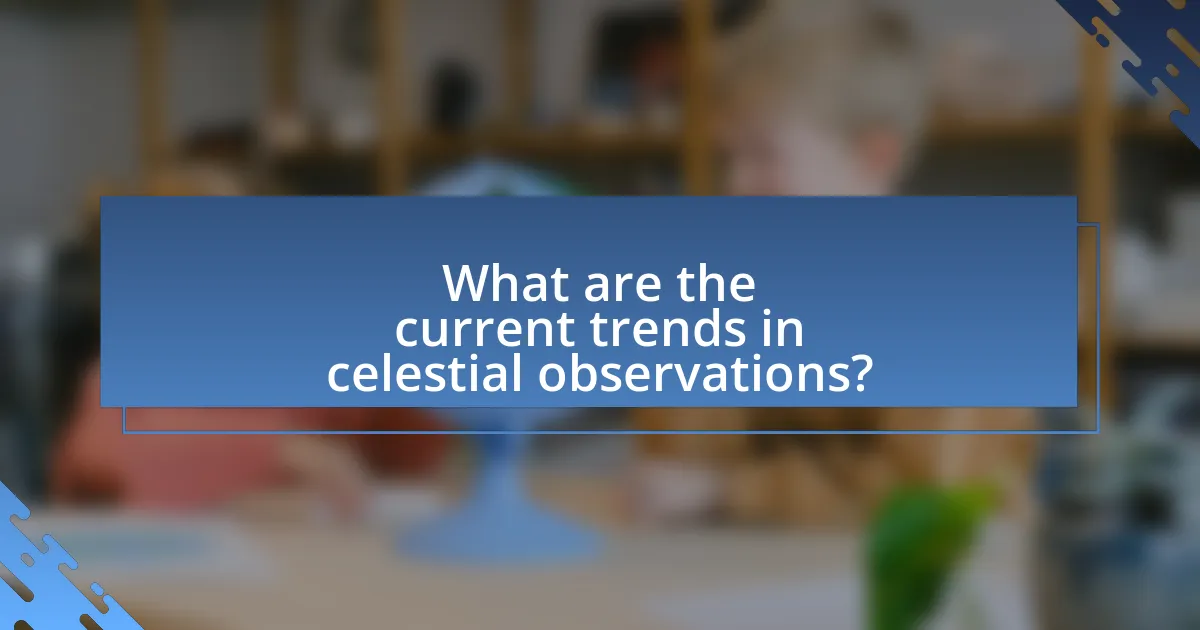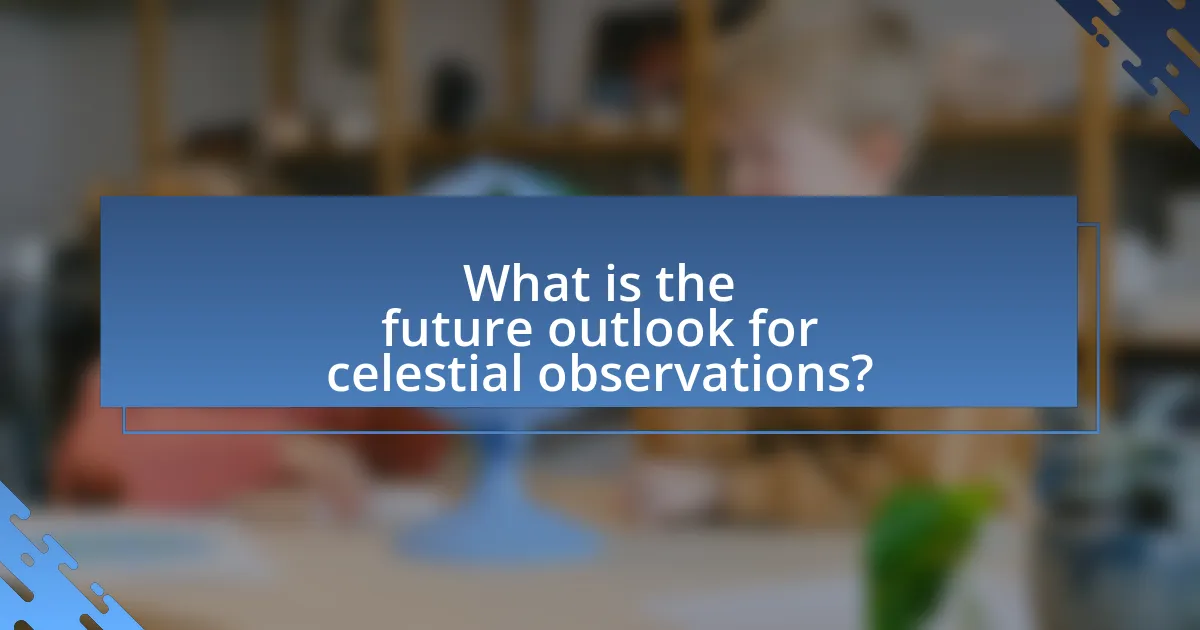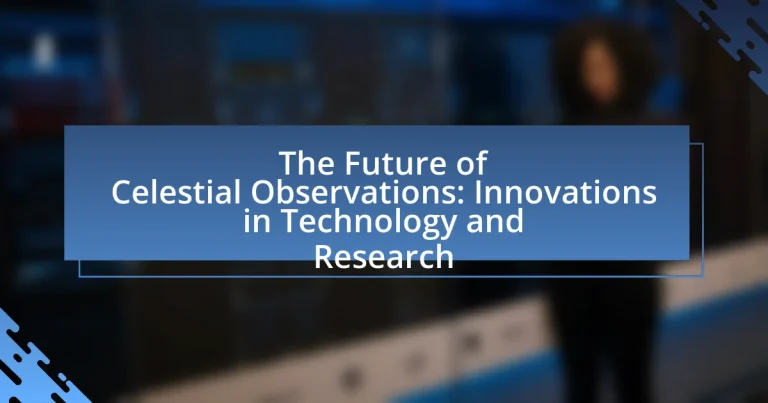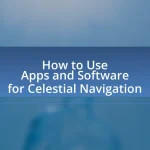The article focuses on the future of celestial observations, highlighting innovations in technology and research that are transforming the field. Key trends include the use of artificial intelligence for data analysis, the deployment of advanced telescopes like the James Webb Space Telescope, and the development of space-based observatories. The article discusses how these technologies enhance data collection and analysis, the challenges faced in celestial observations, and the importance of research and collaboration in driving advancements. Additionally, it explores the impact of light pollution and environmental conditions on observations, as well as the role of AI in improving efficiency and accuracy in astronomical research.

What are the current trends in celestial observations?
Current trends in celestial observations include the increased use of artificial intelligence for data analysis, the deployment of large-scale telescopes like the Vera C. Rubin Observatory, and advancements in space-based observatories such as the James Webb Space Telescope. These trends reflect a shift towards more efficient data processing and enhanced imaging capabilities, allowing astronomers to detect fainter celestial objects and gather more comprehensive data. For instance, the James Webb Space Telescope, launched in December 2021, has already provided unprecedented insights into the early universe, demonstrating the impact of cutting-edge technology on astronomical research.
How are advancements in technology shaping celestial observations?
Advancements in technology are significantly enhancing celestial observations by providing more precise instruments and data analysis capabilities. For instance, the development of high-resolution telescopes, such as the James Webb Space Telescope, allows astronomers to capture detailed images of distant galaxies and exoplanets, revealing information about their composition and formation. Additionally, advancements in artificial intelligence and machine learning enable the processing of vast amounts of astronomical data, improving the identification of celestial phenomena and patterns. These technologies have led to breakthroughs in understanding the universe, such as the detection of gravitational waves and the mapping of dark matter, demonstrating their critical role in modern astronomy.
What specific technologies are being developed for celestial observations?
Specific technologies being developed for celestial observations include advanced telescopes, adaptive optics systems, and space-based observatories. Advanced telescopes, such as the James Webb Space Telescope, utilize infrared technology to observe distant celestial bodies with unprecedented clarity. Adaptive optics systems enhance ground-based telescopes by correcting atmospheric distortions in real-time, allowing for sharper images of astronomical objects. Space-based observatories, like the upcoming Roman Space Telescope, are designed to conduct wide-field surveys of the universe, enabling the discovery of exoplanets and the study of dark energy. These technologies collectively enhance our ability to explore and understand the cosmos.
How do these technologies improve data collection and analysis?
Technologies such as advanced telescopes, artificial intelligence, and big data analytics significantly enhance data collection and analysis in celestial observations. Advanced telescopes, equipped with high-resolution imaging and multi-spectral capabilities, allow astronomers to gather more detailed and diverse data from celestial bodies. Artificial intelligence algorithms process vast amounts of observational data quickly, identifying patterns and anomalies that human analysts might miss. Big data analytics tools enable the integration and analysis of data from multiple sources, facilitating comprehensive studies of cosmic phenomena. For instance, the use of AI in the analysis of data from the Kepler Space Telescope has led to the discovery of thousands of exoplanets, demonstrating the effectiveness of these technologies in improving data collection and analysis.
What role does research play in the future of celestial observations?
Research plays a crucial role in the future of celestial observations by driving advancements in technology and methodologies that enhance our understanding of the universe. For instance, ongoing research in astrophysics and instrumentation leads to the development of more sensitive telescopes and imaging techniques, enabling the detection of faint celestial objects and phenomena. The James Webb Space Telescope, launched in December 2021, exemplifies this, as its research-driven design allows for unprecedented observations of distant galaxies and exoplanets, significantly expanding our knowledge of cosmic evolution. Furthermore, research initiatives like the Event Horizon Telescope project have successfully captured the first image of a black hole, showcasing how collaborative scientific efforts can yield groundbreaking discoveries. Thus, research is integral to refining observational capabilities and expanding the frontiers of astronomy.
What are the key research areas driving innovation in celestial observations?
Key research areas driving innovation in celestial observations include advancements in telescope technology, data analysis techniques, and the study of exoplanets. Telescope technology has evolved with the development of adaptive optics and space-based observatories, enabling clearer images of celestial objects. Data analysis techniques, particularly in machine learning and artificial intelligence, enhance the ability to process vast amounts of astronomical data, leading to new discoveries. The study of exoplanets, facilitated by missions like Kepler and TESS, focuses on identifying and characterizing planets outside our solar system, which has implications for understanding planetary systems and the potential for life beyond Earth. These areas collectively contribute to significant advancements in our understanding of the universe.
How do collaborations between institutions enhance research outcomes?
Collaborations between institutions enhance research outcomes by pooling resources, expertise, and diverse perspectives, which leads to more comprehensive and innovative findings. For instance, joint projects in astronomy often combine advanced technologies and methodologies from different institutions, resulting in improved data collection and analysis. A notable example is the collaboration between NASA and the European Space Agency on the Hubble Space Telescope, which has produced groundbreaking discoveries about the universe, demonstrating that shared knowledge and infrastructure can significantly elevate research quality and impact.

What challenges are faced in the field of celestial observations?
The field of celestial observations faces several significant challenges, including atmospheric interference, light pollution, and the limitations of current technology. Atmospheric interference, caused by weather conditions and the Earth’s atmosphere, can distort or obscure astronomical images, making it difficult to obtain clear data. Light pollution from urban areas significantly hampers the ability to observe faint celestial objects, as artificial lighting washes out the night sky. Additionally, current observational technology, while advanced, still has limitations in resolution and sensitivity, which restricts the ability to detect and analyze distant or dim celestial phenomena. These challenges necessitate ongoing innovation and research to enhance observational capabilities and improve data accuracy.
How does light pollution affect celestial observations?
Light pollution significantly hinders celestial observations by obscuring the visibility of stars and other astronomical objects. This phenomenon occurs when artificial light brightens the night sky, making it difficult for both amateur and professional astronomers to detect faint celestial bodies. Studies indicate that light pollution can reduce the visibility of stars by up to 90% in urban areas, severely limiting the ability to conduct astronomical research and observations. For instance, the International Dark-Sky Association highlights that excessive artificial lighting interferes with the natural darkness required for optimal stargazing and astrophotography, ultimately impacting the quality of data collected in astronomical studies.
What measures can be taken to mitigate the impact of light pollution?
To mitigate the impact of light pollution, implementing shielded outdoor lighting fixtures is essential, as these fixtures direct light downward and reduce glare. Additionally, using lower-intensity lighting and adopting smart lighting controls, such as timers and dimmers, can significantly decrease unnecessary illumination during off-peak hours. Research indicates that over 30% of outdoor lighting is wasted due to poor design, which contributes to light pollution and can be addressed through these measures. Furthermore, promoting public awareness about the effects of light pollution and encouraging community involvement in local lighting ordinances can enhance efforts to reduce its impact.
How do astronomers adapt to changing environmental conditions?
Astronomers adapt to changing environmental conditions by utilizing advanced technology and flexible observational strategies. For instance, they employ adaptive optics systems that compensate for atmospheric turbulence, allowing for clearer images of celestial objects. Additionally, astronomers often select observation sites based on environmental stability, such as high-altitude locations with minimal light pollution and atmospheric interference. Research has shown that these methods significantly enhance data quality, as evidenced by the success of telescopes like the Keck Observatory, which uses adaptive optics to improve resolution by a factor of 10 compared to traditional methods.
What are the limitations of current observational technologies?
Current observational technologies face several limitations, including resolution constraints, atmospheric interference, and data processing challenges. Resolution constraints hinder the ability to discern fine details in celestial objects, as many telescopes are limited by their aperture size and the diffraction limit. Atmospheric interference, particularly from Earth’s atmosphere, distorts images and limits observations in certain wavelengths, necessitating the use of adaptive optics or space-based telescopes to mitigate these effects. Additionally, data processing challenges arise from the vast amounts of data generated by modern observational instruments, requiring advanced algorithms and significant computational resources to analyze and interpret the information effectively. These limitations collectively impact the accuracy and comprehensiveness of celestial observations.
How do these limitations affect the accuracy of celestial data?
Limitations in celestial observations, such as atmospheric interference, instrument sensitivity, and data processing algorithms, significantly reduce the accuracy of celestial data. Atmospheric interference can distort light from celestial bodies, leading to inaccuracies in position and brightness measurements. Instrument sensitivity affects the ability to detect faint objects, resulting in incomplete data sets. Furthermore, data processing algorithms may introduce errors during analysis, compounding inaccuracies. For instance, studies have shown that atmospheric turbulence can lead to position errors of several arcseconds, which is critical in precise astronomical measurements.
What innovations are being explored to overcome these limitations?
Innovations being explored to overcome limitations in celestial observations include adaptive optics, space-based telescopes, and advanced data processing algorithms. Adaptive optics technology corrects atmospheric distortions in real-time, significantly enhancing image clarity from ground-based observatories. Space-based telescopes, such as the James Webb Space Telescope, eliminate atmospheric interference altogether, allowing for clearer and more detailed observations of distant celestial bodies. Additionally, machine learning algorithms are being developed to analyze vast amounts of astronomical data more efficiently, enabling researchers to identify patterns and anomalies that would be difficult to detect manually. These innovations collectively aim to improve the accuracy and depth of celestial observations, addressing challenges posed by atmospheric conditions and data overload.

What is the future outlook for celestial observations?
The future outlook for celestial observations is highly promising, driven by advancements in technology and innovative research methodologies. The development of next-generation telescopes, such as the James Webb Space Telescope, enhances our ability to observe distant galaxies and exoplanets with unprecedented clarity. Additionally, the integration of artificial intelligence in data analysis allows for more efficient processing of vast amounts of astronomical data, leading to quicker discoveries. Furthermore, international collaborations, like the Square Kilometre Array, aim to revolutionize radio astronomy, providing deeper insights into cosmic phenomena. These advancements collectively indicate a significant enhancement in our observational capabilities, paving the way for groundbreaking discoveries in the field of astronomy.
How will artificial intelligence influence celestial observations?
Artificial intelligence will significantly enhance celestial observations by improving data analysis, automating image processing, and enabling real-time decision-making. AI algorithms can analyze vast amounts of astronomical data more efficiently than traditional methods, allowing for the identification of celestial objects and patterns that may have been overlooked. For instance, machine learning techniques have been successfully applied to classify galaxies and detect exoplanets, as demonstrated in studies like “Deep Learning for Astronomical Image Analysis” published in Nature Astronomy, which highlights AI’s capability to outperform human researchers in specific tasks. This integration of AI into celestial observations not only accelerates research but also increases the accuracy of findings, ultimately advancing our understanding of the universe.
What specific applications of AI are being utilized in this field?
AI is being utilized in celestial observations primarily for data analysis, image processing, and anomaly detection. In data analysis, machine learning algorithms process vast amounts of astronomical data to identify patterns and classify celestial objects, significantly enhancing the efficiency of research. Image processing applications involve using AI to enhance the quality of images captured by telescopes, allowing for clearer observations of distant galaxies and other celestial phenomena. Anomaly detection systems leverage AI to automatically identify unusual events, such as supernovae or transient astronomical phenomena, which might otherwise go unnoticed. These applications are supported by advancements in AI technologies, such as convolutional neural networks, which have demonstrated high accuracy in classifying astronomical images and detecting anomalies in large datasets.
How does AI enhance the efficiency of data processing in celestial research?
AI enhances the efficiency of data processing in celestial research by automating the analysis of vast datasets generated by telescopes and satellites. This automation allows researchers to quickly identify patterns, classify celestial objects, and detect anomalies that would be time-consuming for humans to process. For instance, machine learning algorithms can analyze images from the Hubble Space Telescope, significantly reducing the time required to catalog new galaxies or identify exoplanets. Studies have shown that AI can improve data processing speed by up to 100 times compared to traditional methods, enabling astronomers to make discoveries at an unprecedented pace.
What are the best practices for engaging with new technologies in celestial observations?
The best practices for engaging with new technologies in celestial observations include continuous education, collaboration with experts, and hands-on experimentation. Continuous education ensures that astronomers stay updated on the latest advancements, such as adaptive optics and machine learning algorithms, which enhance image quality and data analysis. Collaboration with experts in fields like data science and engineering fosters interdisciplinary approaches, leading to innovative solutions for complex observational challenges. Hands-on experimentation allows researchers to test new instruments and techniques, facilitating practical understanding and adaptation to evolving technologies. These practices are supported by the increasing integration of technology in astronomy, as evidenced by the success of projects like the James Webb Space Telescope, which utilized cutting-edge technology to achieve unprecedented observations.
How can researchers stay updated with the latest innovations?
Researchers can stay updated with the latest innovations by regularly engaging with scientific journals, attending conferences, and participating in professional networks. Scientific journals such as “Nature” and “The Astrophysical Journal” publish cutting-edge research, while conferences like the American Astronomical Society meetings provide platforms for sharing new findings. Additionally, professional networks and online platforms like ResearchGate and LinkedIn facilitate collaboration and information exchange among researchers, ensuring they remain informed about advancements in their field.
What resources are available for training in new observational technologies?
Resources available for training in new observational technologies include online courses, workshops, and academic programs. Institutions such as the American Astronomical Society offer webinars and training sessions focused on the latest observational techniques. Additionally, platforms like Coursera and edX provide courses on data analysis and instrumentation relevant to observational astronomy. Research institutions often host summer schools and internships that provide hands-on experience with cutting-edge technologies. These resources are validated by the increasing number of participants and collaborations in the field, demonstrating their effectiveness in enhancing skills and knowledge in new observational methods.


